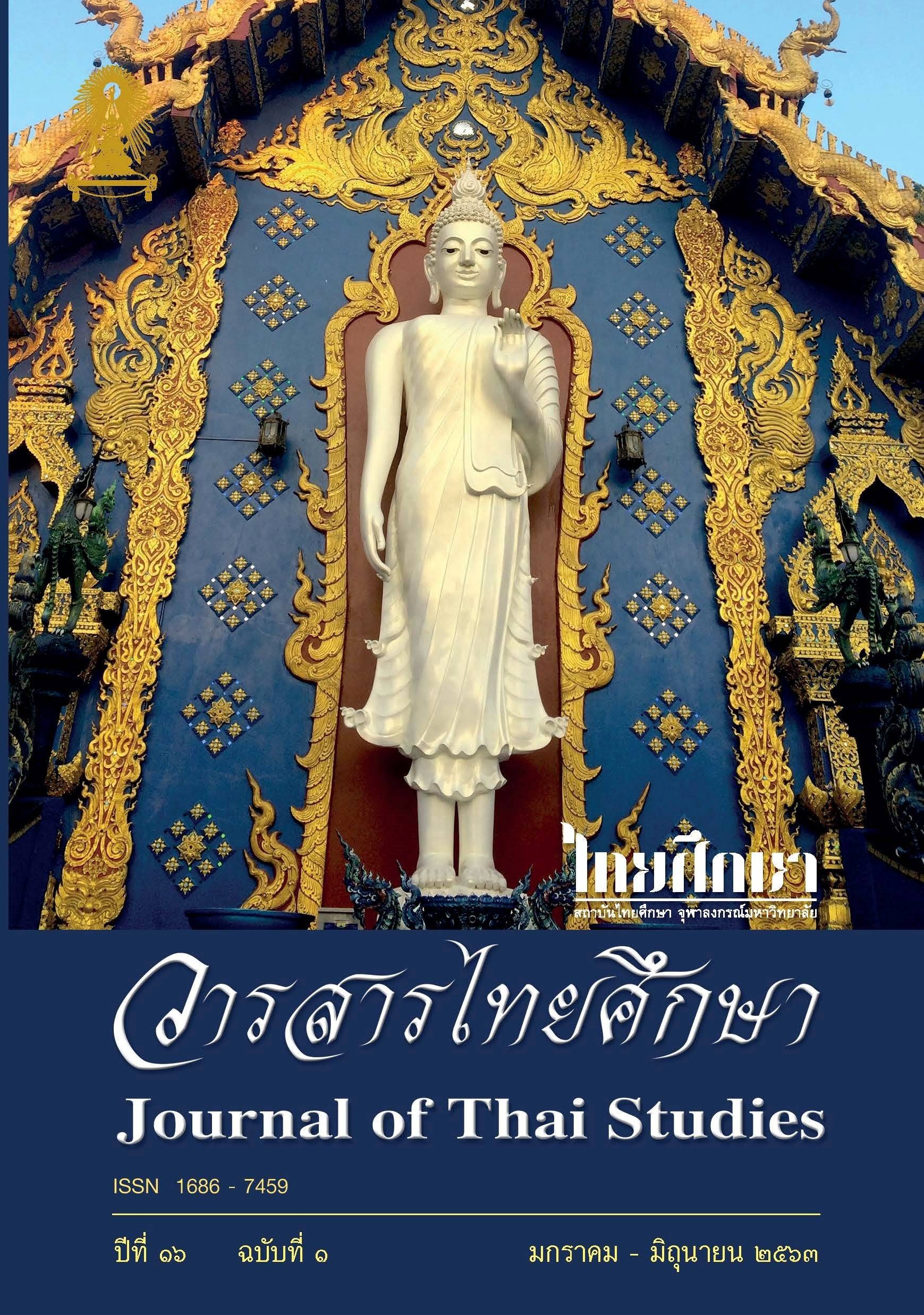Chao Sen Procession (Muharram) Paintings in the Ubosot of Wat Pho Pathomawat in Songkhla Province : Political Conflicts and Ethnic Diversity in the Southern Region in the Early Bangkok Period
Main Article Content
Abstract
This article aims to study the Chao Sen Procession (Muharram) paintings in the Ubosot of Wat Pho Pathomawat in Songkhla province and investigate political conflicts and ethnic diversity in the southern region of Thailand during the Early Bangkok period in which the paintings are contextualized. The study shows that the paintings illustrate a procession that commemorated the deaths of Imam Hussen and his followers slaughtered by Yasid I’s soldiers at Karbara. In the Thai context, the paintings illustrate ethnic diversity in Songkhla, including Muslim, Thai and Chinese culture. Furthermore, the paintings are related to ethnic group fighting paintings and Thai and Chinese funeral ceremony paintings. This article is an example of a study of folklore used to understand political conflicts and ethnic diversity of different beliefs in southern Thailand during the Early Bangkok period.
Downloads
Article Details

This work is licensed under a Creative Commons Attribution-NonCommercial-NoDerivatives 4.0 International License.
Journal of Thai studies is licensed under a Creative Commons Attribution-Noncommercial-NoDerivatives4.0 Intenational (CC BY-NC-ND 4.0) licence, unless otherwise stated. Plese read our Policies page for more information on Open Access, copyright and permissions.
References
Amornwanitsak, S. (2018). “Chaopho Khao Tok” Thepharak Thai Thi Klaipen Thepphachao Chin [“Chaopho Khao Tok” Thai Guardian God becomes a Chinese God]. Nonthaburi: Tonchabap.
Ampai, K. (2005) The mural paintings in Phra Ubosoth at Wat Pho Pathamawat, Songkhla: the reflection of society and culture in Songkhla community in early Rattanakosin period. (Master’s thesis). Department of Art History, Silpakorn University, Bangkok, Thailand.
Bunnag, P. (1977). Botbat Thang Kanmueang Kan Pokkhrong Khong Senabodi Trakun Bunnag [The political role of the Bunnag Family]. Bangkok: Duangkamon.
Chularatana, J. (2001).The Krom Tha Khwa Officials: Their roles and functions during the Ayutthaya and Rattanakosin periods (1610-1892). (PhD dissertation). Department of History, Chulalongkorn University, Bangkok, Thailand.
Chularatana, J. (2007). “Khaek” Nai Khlong phap Khon Tang Phasa Thi Wat Pho Phapsathon Mutsalim Sueksa Nai Mu Panyachon Sayam Samai Ton Rattanakosin [“Khaek” in Khlong Phap Khon Tang Phasa at Wat Pho: A reflection of Muslim Studies in Rulers of Siam in the early Rattanakosin period]. Journal of Letters, 36, (1), 36 - 111.
Chuangphichit, T. (2008). Chao Sen Rite (Ashura): Ethnic identity and ethnicity of Shi’ite Muslims of Thailand. (Master ‘s thesis). Silpakorn University, Bangkok, Thailand.
Fine Arts, Department. (2012). Thamniapnam Laeng Moradok Thang Sinlapawatthanatham Nai Khet Phuenthi Ha Changwat Chaidaen Phaktai [List of Cultural Heritage Sites in the five southern border provinces]. Songkhla: Bangkok in House.
Kancanakhaphan. (1973) Phumisat Wat Pho, lem 1 [Geography of Wat Pho, Volume 1]. (2nd ed.). Bangkok: Ruamsan.
King Rama III Archives. (1839). Vajirayana Library, Number. 112.
Kunsirisawat, D. (1974). Khwamsamphan Khong Mutsalim Thang Prawattisat lae Wannakhadi Thai Lae Samphao Kasat Sulaiman (Chabap yo) [The relationship of Muslims in History and Thai Literature and the ship of Sulaiman (abridged version)]. (2nd ed.). Bangkok: Language and Book Association of Thailand.
Lomlim, T. (1973). Khwamsamphan Rawang Thai Kap Malayu Nai Samai Rattanakosin Tonton [The relationship between the Thai and Malay in the early Rattanakosin period]. Bangkok: Phrae Pithaya.
Nakrop, S. (2013). The Marasia Lamentation in Muharram Observance of the Shia Muslim in Thailand. Manutsayasat Wichakan 20, (1), 153 - 180.
Phaluekmonthon, D. (2016). Chao Chin Lang Khwam Tai [Chinese Afterlife. Retrieved from http://lek-prapai.org/home/view.php?id=905&fbclid=IwAR1sWgKguOi3xjT_ePalcdIFK_F32asDR8rBMJwyVGQSORYpYWn_CDji90
Phibunsiri, M. (2005). Semiotic communication management through “Muharom Ritual for Shi-ah Muslim (Master’s thesis). Thammasat University, Bangkok, Thailand.
Phongphaibun, S. (2000). Katho Sanim Krit: Lae Withichiwit Chao Tai Ton lang [Stripping the rust from the dagger: A look at the way of life of Thai Southerners]. Bangkok: The Thailand Research Fund.
Phongsiribanyat, P. (1979). The government policy towards Songkhla during the Rattanakosin period (A.D. 1782-1896). (Master‘s thesis). Department of History, Chulalongkorn University, Bangkok, Thailand.
Prachum Charuek Wat Phra Chetuphon [Stone Inscriptions of Wat Pho]. (1974). (3rd ed.). Bangkok: Siwaphon.
Prachum Phongsawadan, lem 30 [Historical chronicles, Volume 30]. (1968). Bangkok: Rongphim Khurusapha Latphra.
Pramoj, K, M.R. (2001). Khrong Kraduk Nai Tu [Skeleton in the Closet]. (5th ed.). Bangkok: Dokya.
Rueangraklikhit, C. (2009). Kap He Chom Khrueang Khao Wan Kap He Nirat Raem Rot Rang [Processional verses Chom Khrueang Khao Wan and Nirat Raem Rot Rang]. Bangkok: Chulalongkorn University Press.
Saranukrom Thai Chabap Ratchabandittayasathan, lem 4 [Thai Encyclopaedia of The Royal Institute of Thailand, Volume 4]. (1960-1961). Phranakhon: Rungrueang Tham.
Sikkhakoson, T. (2014). Thetsakan Chin Lae Kan Sen Hai [Chinese Festivals and Sacrificial Offerings]. Bangkok: Matichon.
Wichian khiri (Bunsang), Phraya. (1933). Chronicle of Songkhla in Historical chronicles Number 53, Chronicle of Songkhla, Chronicle of Nakhon Si Thammarat, Chronicle of Phatthalung.


